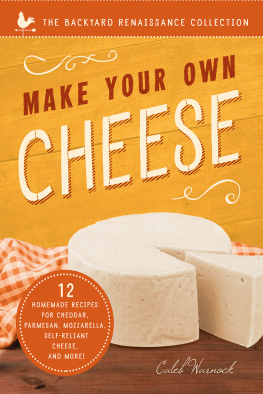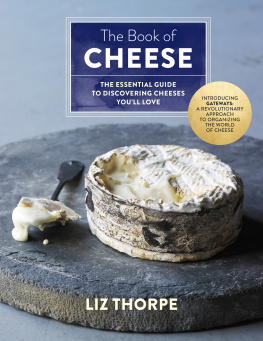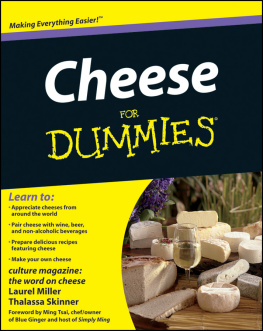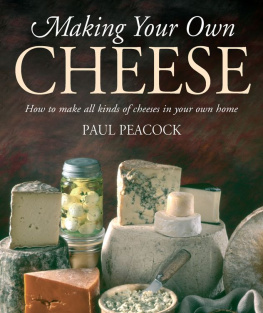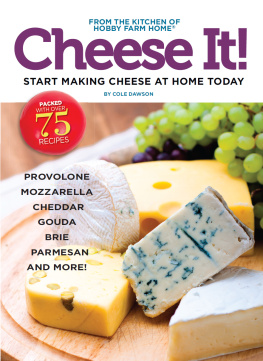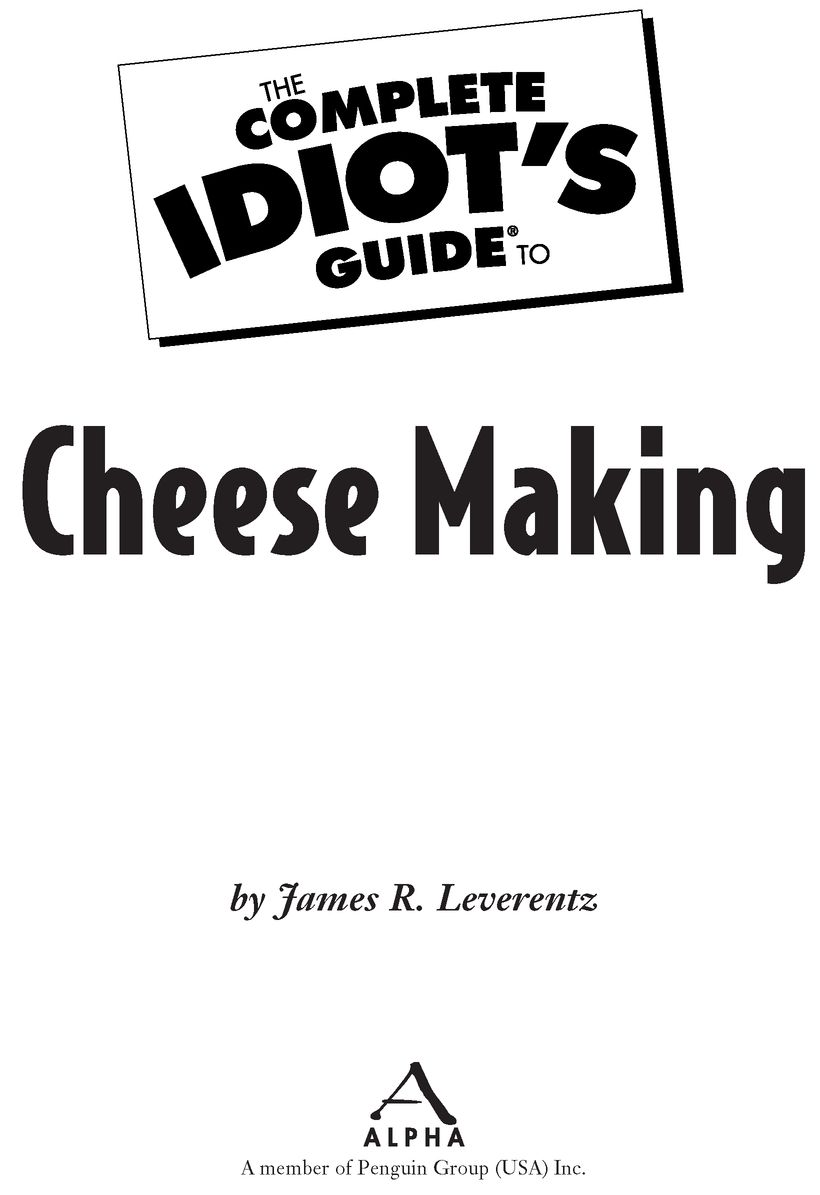Table of Contents
Introduction
There are two things you must know about cheese making before anything in this book will make sense. First, cheese making, on any scale, is chemistry and biology, not cooking or baking. Second, cheese making requires artful skills born of attentive patience. The blending of science and art into the process of changing milk into cheese is as close to culinary alchemy as you can get. This book is meant to teach you both the technology and art of personal cheese making in an entertaining and appetizing way.
The first cheese I tried to make was cheddar. It took the better part of a day to prepare the cheese and a week to get it ready for waxing, followed by months of aging and anticipating the final results. In the end, the cheese was moldy, flavorless, dry, and crumbly. My mistake was starting in the middle and working in two directions at once. Knowledge of cheese making starts at the beginning and builds on the foundation of experience. It is not that making cheese is difficult. Making cheese is different.
Do not look at this book as a cookbook-style collection of cheese-making recipes. Most common cookbooks and many cheese-making volumes are written so that each recipe is independent of the others. These books also include assumptions, with a few notable exceptions, of the readers subject knowledge and basic cooking skills. Teaching you to make your own cheese requires that no assumptions be made and that you will travel through the chapters of this book in the order they are presented. You must be able to assess each new recipe process with the background and experience you will have gained from preceding recipes.
If a comparison of cheese making and another culinary effort is needed, it would have to be with the brewing of beer. Beer is made of four primary ingredients (water, malt, hops, and yeast), yet there are over 6,000 documented styles of beer worldwide. It is the brewmasters skill at manipulating these ingredients that makes one beer different from another. The seasoned cheesemaker also uses four primary ingredients (dairy milk, microorganisms, enzymes, and salt), yet is capable of producing over 3,000 documented cheese styles in the United States alone. In both brewing and cheese making, the secrets to success are in the process rather than the recipe.
Making cheese in your kitchen is not unlike making it in a creamery or factory. The ingredients are the same. The terminology used to describe the process is the same. Even the need for strict sanitation and environmental controls are the same. The most notable difference is your source of raw material. All of the recipes given here are formulated to be made with store-bought cows milk. Yes, the milk at the supermarket can be used to make very good cheese. These recipes will also work equally as well or better with fresh milk from dairy animals, provided that the milk is cared for properly.
The greatest difference between your kitchen cheese and commercial creamery cheese will be the volume of milk used and therefore the amount of cheese produced by a single batch. The included recipes have been formulated based on two critical factors. First is the minimum amount of milk that can be used to produce a satisfactory cheese, and second is the maximum amount of milk that can be easily managed in the average kitchen using household-size utensils.
You will start your cheese-making adventure by making very simple, yet tasty and useful, cheeses made from store-bought dairy products. You will then progress through the entire collection of cheese styles, including soft cheese, semi-hard cheese, ripened cheese, hard cheese, and aged cheese. Each cheese-making session will combine experiences from previous recipes and introduce new techniques and/or the use of new ingredients.
Some cheeses you may want to make simply cannot be created on a small scale. Swiss cheese, with its signature large holes (called eyes), requires a wheel size of 10 to 20 pounds to provide space for the eyes to grow. Parmesan requires raw milk and takes over a year to produce. Rather than dedicate valuable space to facsimiles of these cheeses, I have limited the variety of cheese recipes to cover popular styles that teach the methodology of cheese making. You may not find the recipe you are looking for, but you will learn the cheese-making techniques and skills needed to produce it. You will be learning valuable skills that may lead you to new pastures (pun intended), but please note that the information given here is in no way a comprehensive representation of the cheese-making art.
Knowing how to use the finished cheese is as important as being able to make it. Recipes for dishes ranging from snacks to desserts are included for each cheese type. You will learn to recognize and exploit the special characteristics and flavors of all cheese styles.
If your interest in cheese making is purely academic and you never actually make your own cheese, by reading this book you will gain an insightful appreciation for the art of cheese making and an increased understanding of the unique textures and delicious flavors within a given cheese.
How This Book Is Organized
Cheese making requires honing skills that come from the experience of trial and error. This book progresses methodically from understanding the terminology, tools, and making of basic cheeses before moving on to the making of more advanced styles of cheeses.
In Part 1, The Composition of Cheese, you will learn the physical composition of cheese, all about milk and starter cultures used for cheese making, and the tools required.
In Part 2, Making Quick Cheeses, you will embark on making fresh cheeses by the direct-acidification method, including paneer, mozzarella, and crme frache. You will also learn how to use cheesecloth and make culture-ripened fresh cheeses.
Part 3, Cultured Cheese and Conventional Cheese Making, details the formal cheese-making process step by step and moves into more advanced cheese making, including hard and brined cheeses such as cheddar and Baby Swiss.
Sidebars
Helpful and interesting information is provided throughout the book in sidebars to assist you in learning about cheese and the making of cheese.
Cheese Bite
Tips and helpful hints about cheeses and the process of making them.
Whey Watch
Things to avoid or be cautious of when making cheese.
definition
Cheese-making terms and tools explained.
Tasty Chatter
Interesting facts and information about the world of cheese.
Acknowledgments
I must thank my wife Eileen and all of the Leeners staff for picking up the workload and filling in for me and others as I diverted resources, leaving them shorthanded. A special thank you goes to Joellen Ionni for her hours spent in our test kitchen perfecting the recipes and techniques used in this book. This project could not have been accomplished without her assistance. I wish to thank Carol Jenkins for monitoring my literary voice and helping to translate my sometimes random thoughts into coherent sentences; and my assistant Crystal Wisniewski, who acted as coordinator, researcher, and proofreader.


